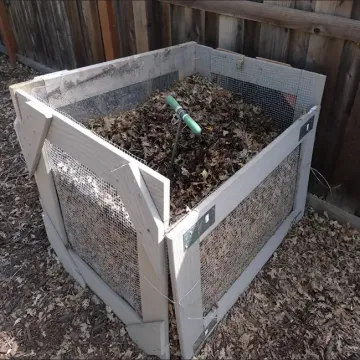Composting is a process that transforms organic materials from the kitchen, garden, and lawn into a rich, nutrient-dense soil amendment known as compost. This article explores composting, its benefits, how to use compost in the garden, the process involved in composting, and tips for speeding up the process.
What is Composting?
Composting involves decomposing organic matter facilitated by microorganisms, oxygen, and moisture. The result is a dark, crumbly substance called humus, which enriches the soil with essential nutrients and improves its structure.
Benefits of Using Compost in the Garden
- Soil Enrichment: Using compost in your garden adds nutrients to plants' soil for healthy growth.
- Reduced Need for Chemical Fertilizers: Compost reduces the need for synthetic fertilizers by providing a steady supply of nutrients, promoting a more sustainable gardening practice.
- Enhanced Soil Microbial Activity: Compost introduces beneficial microbes that help break down organic matter, making nutrients more available to plants. These microbes also help suppress soil-borne diseases.
How to Use Compost in the Garden
- Soil Amendment: Mix compost into garden beds before planting to improve soil fertility and structure. A 2-3 inches layer worked into the top 6-8 inches of soil is typically sufficient.
- Mulch: Apply compost as a mulch around plants to help retain moisture, suppress weeds, and gradually release nutrients into the soil.
- Top Dressing: Throughout the year, you can add a layer of compost to the soil as a top dressing. This layer can act as a mulch and will add nutrients to the soil. Top dressing at the end of the season is also a great way to get the garden set up for the spring.
The Composting Process
Composting involves breaking organic materials driven by microorganisms through a series of stages. The process can be divided into several key phases:
- Mesophilic Phase: During this initial phase, mesophilic bacteria (which thrive at moderate temperatures) break down the easily degradable compounds, raising the pile's temperature.
- Thermophilic Phase: As the temperature increases, thermophilic bacteria (which thrive at higher temperatures) take over, breaking down more rigid materials like cellulose and lignin. At this point, the compost pile becomes hot, often reaching 130-160°F (55-70°C).
- Cooling Phase: After the most easily degradable materials are consumed, the temperature begins to drop, and mesophilic bacteria return to finish breaking down the remaining organic matter.
- Maturation Phase: The compost stabilizes and decomposes slowly, allowing the material to mature and become fully ready for use in the garden.
The Role of Microbes
Microorganisms are the driving force behind composting. Bacteria, fungi, and actinomycetes (filamentous bacteria) work together to break down organic matter. Bacteria are the most active, initiating the breakdown of complex molecules. Fungi help decompose tougher materials like lignin, and actinomycetes play a crucial role in breaking down cellulose and other complex compounds.
Why Does Compost Get Hot?
As microbes break down organic matter, they release energy in the form of heat. This heat is essential for the thermophilic composting phase, which helps accelerate decomposition and kill off weed seeds and pathogens.
Phases of Hot Composting
Hot composting is an accelerated composting method that involves maintaining a compost pile at high temperatures (130-160°F) to speed up decomposition. The phases include:
- Initial Heating: Microbial activity raises the temperature rapidly.
- Active Decomposition: The pile reaches its highest temperature as thermophilic microbes break down organic matter.
- Cooling: As easily digestible materials are consumed, the temperature drops.
- Maturation: The compost cools further, stabilizes, and is ready for use.
Balancing Greens and Browns
A successful compost pile relies on a balance between "greens" and "browns."
- Greens are nitrogen-rich materials like vegetable scraps, grass clippings, and coffee grounds. They provide the necessary nitrogen for microbial growth and activity.
- Browns are carbon-rich materials like dry leaves, straw, and paper. They provide carbon, which is essential for energy and maintaining the structure of the compost pile.
A good ratio is 2-3 parts browns to 1 part greens.
Candidates for Composting
Compostable materials include:
- Vegetable and fruit scraps
- Coffee grounds and tea leaves
- Eggshells
- Grass clippings and yard waste
- Leaves and straw
- Paper products (newspaper, cardboard, paper towels)
- Wood chips and sawdust (in small amounts)
Avoiding Diseased or Pest-Infected Material
It's essential to avoid adding diseased plants, pest-infested material, or weed seeds to your compost pile. While hot composting can kill off many pathogens and weed seeds, if the pile doesn't reach high enough temperatures, these problems could persist and spread when the compost is used in the garden.
How to Speed Up the Composting Process
- Proper Moisture: Keep the compost pile relatively moist. If the pile is too dry, the decomposition process will be prolonged. Conversely, if the pile is too wet, an anaerobic condition will exist, which will cause decomposition.
- Aeration: Mix or turn the pile regularly to introduce oxygen. Frequent turning can significantly speed up the decomposition process.
- Shred Materials: A leaf shredder is an excellent tool for accelerating decomposition. Breaking the leaves into smaller pieces increases the surface area, which allows microbes to work faster.
- Balance Greens and Browns: Carbon and organic matter need to be balanced. Mixing greens like kitchen scraps with dead leaves and grasses will provide this balance.
Composting reduces waste and enriches garden soil. By understanding the process, balancing greens and browns, and maintaining the right conditions, you can produce high-quality compost that benefits your garden for years.

